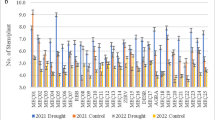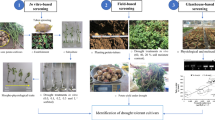Abstract
Abiotic stresses are the major constraint that limits the productivity of potatoes. Among all the major abiotic stresses, drought is the main stress that is increasing on a yearly basis. Therefore, the current field study was conducted to evaluate the morphological and yield characteristics of 29 potato genotypes. Plants were divided into control and drought stress groups, and plants were acclimatized to drought stress 45 days after sowing (DAS). The irrigation regime was maintained at 3-day interval for control group plants, while for the drought stress treatment, the field was irrigated at 6-day interval. Performance of potato plants was observed by measuring morpho-physiological and yield traits that included canopy temperature, chlorophyll contents, growth duration, plant height, stand establishment, and number of stems per plant. Finally, potato tuber traits were measured (number of tubers, tuber weight, and marketable tuber weight). All potato breeding lines showed contrasting behaviour in response to drought stress. Results showed that potato breeding lines 7, 9, 11, 20, 12, 16, 22, 21, 10, and 18 suggested tolerance as they showed the least reduction in yield characteristics, whereas genotypes 1, 26, 24, 4, 27, 6, 8, 29, 23, 26, 3, and 5 showed poor performance as they failed to cope with stress conditions. Broad sense heritability showed 77% variability that suggested decreased effect of environment on potato genotypes for the selection of high-yielding tubers. The resilient potato breeding lines showed the potential to be stably used as potato breeding material for stress tolerance. These tolerant lines can be used by future breeding programmes to develop resilient cultivars to cope with drought stress problems and to ensure food security.




Similar content being viewed by others
References
Aliche EB, Oortwijn M, Theeuwen TP, Bachem CW, Visser RG, van der Linden CG (2018) Drought response in field grown potatoes and the interactions between canopy growth and yield. Agri Water Manag 206:20–30. https://doi.org/10.1016/j.agwat.2018.04.013
Batool T, Ali S, Seleiman MF, Naveed NH, Ali A, Ahmed K, Mubushar M (2020) Plant growth promoting rhizobacteria alleviates drought stress in potato in response to suppressive oxidative stress and antioxidant enzymes activities. Sci Rep 10(1):16975. https://doi.org/10.1038/s41598-020-73489-z
Campos H, Ortiz O (2020) The potato crop: its agricultural, nutritional and social contribution to humankind (p. 518). Springer Nature. https://doi.org/10.1007/978-3-030-28683-5
Dahal K, Li XQ, Tai H, Creelman A, Bizimungu B (2019) Improving potato stress tolerance and tuber yield under a climate change scenario—a current overview. Front Plant Sci 10:563. https://doi.org/10.3389/fpls.2019.00563
Demirel U, Morris WL, Ducreux LJ, Yavuz C, Asim A, Tindas I, Campbell R, Morris JA, Verrall SR, Hedley PE, Gokce ZN (2020) Physiological, biochemical, and transcriptional responses to single and combined abiotic stress in stress-tolerant and stress-sensitive potato genotypes. Front Plant Sci 169. https://doi.org/10.3389/fpls.2020.00169
Devaux A, Goffart JP, Kromann P, Andrade-Piedra J, Polar V, Hareau G (2021) The potato of the future: opportunities and challenges in sustainable agri-food systems. Potato Res 64:681–720. https://doi.org/10.1007/s11540-021-09532-x
FAOSTAT (2021) Statistical division of the UN food and agriculture Organization of the United Nations. http://faostat.fao.org/ Accessed on 22 December 2022
Gervais T, Creelman A, Li XQ, Bizimungu B, De Koeyer D, Dahal K (2021) Potato response to drought stress: physiological and growth basis. Front Plant Sci 12: 698060. https://doi.org/10.3389/fpls.2021.698060
Gustavsen GW (2021) Sustainability and potato consumption. Potato Res 64(4):571–586. https://doi.org/10.1007/s11540-021-09493-1
Handayani T, Gilani SA, Watanabe KN (2019) Climatic changes and potatoes: how can we cope with the abiotic stresses? Breed Sci 69:545–563. https://doi.org/10.1270/jsbbs.19070
Harun-Or-Rashid M, Miah MB, Islam SS (2021) In vitro morphophysiological screening of drought-tolerant potato genotypes. In Vitro Cell Dev Biol 57:519–528. https://doi.org/10.1007/s11627-020-10155-z
Hill D, Nelson D, Hammond J, Bell L (2021) Morphophysiology of potato (Solanum tuberosum) in response to drought stress: paving the way forward. Front Plant Sci 11: 597554. https://doi.org/10.3389/fpls.2020.597554
Mahmud AA, Hossain MM, Karim MA, Mian MK, Zakaria M, Kadian MS (2016) Plant water relations and canopy temperature depression for assessing water stress tolerance of potato. Indian J Plant Physiol 21:56–63. https://doi.org/10.1007/s40502-015-0202-3
Meise P, Seddig S, Uptmoor R, Ordon F, Schum A (2019) Assessment of yield and yield components of starch potato cultivars (Solanum tuberosum L.) under nitrogen deficiency and drought stress conditions. Potato Res 62:193–220. https://doi.org/10.1007/s11540-018-9407-y
Monneveux P, Ramirez DA, Pino MT (2013) Drought tolerance in potato (S. tuberosum L.): can we learn from drought tolerance research in cereals? Plant Sci 205:76–86. https://doi.org/10.1016/j.plantsci.2013.01.011
Mthembu SG, Magwaza LS, Mashilo J, Mditshwa A, Odindo A (2022) Drought tolerance assessment of potato (Solanum tuberosum L.) genotypes at different growth stages, based on morphological and physiological traits. Agric Water Manag 261: 107361. https://doi.org/10.1016/j.agwat.2021.107361
Muleta HD, Aga MC (2019) Role of nitrogen on potato production: a review. J Plant Sci 7:36–42. https://doi.org/10.11648/j.jps.20190702.11
Naawe EK, Caliskan EM (2021) Effects of genotype by environment interaction on the yield and quality traits of potato breeding lines in the Central Anatolia region of Turkey. III. Balkan Agriculture Congress, Edirne, Turkey, 29 August - 1 September 2021. 769–790
Nasir MW, Toth Z (2022) Effect of drought stress on potato production: a review. Agronomy 12(3):635. https://doi.org/10.3390/agronomy12030635
Obidiegwu JE, Bryan GJ, Jones HG, Prashar A (2015) Coping with drought: stress and adaptive responses in potato and perspectives for improvement. Front Plant Sci 6:542. https://doi.org/10.3389/fpls.2015.00542
Pour-Aboughadareh A, Yousefian M, Moradkhani H, Poczai P, Siddique KHM (2019) STABILITYSOFT: a new online program to calculate parametric and non-parametric stability statistics for crop traits. Appl Plant Sci 7:121. https://doi.org/10.1002/aps3.1211
Rolando JL, Ramírez DA, Yactayo W, Monneveux P, Quiroz R (2015) Leaf greenness as a drought tolerance related trait in potato (Solanum tuberosum L.). Environ Exp Bot 110:27–35. https://doi.org/10.1016/j.envexpbot.2014.09.006
Şanlı BA, Gökçe ZNÖ (2021) Investigating effect of miR160 through overexpression in potato cultivars under single or combination of heat and drought stresses. Plant Biotechnol Rep 15(3):335–348. https://doi.org/10.1007/s11816-021-00677-2
Saeed F, Chaudhry UK, Raza A, Charagh S, Bakhsh A, Bohra A, Ali S, Chitikineni A, Saeed Y, Visser RG, Siddique KH (2023) Developing future heat-resilient vegetable crops. Funct Integr Genomics 23(1):47. https://doi.org/10.1007/s10142-023-00967-8
Schittenhelm S, Sourell H, Löpmeier FJ (2006) Drought resistance of potato cultivars with contrasting canopy architecture. Eur J Agron 24(3):193–202. https://doi.org/10.1016/j.eja.2005.05.004
Steel RGD, Torrie JH, Dicky DA (1997) Principles and procedures of statistics. A biometrical approach. 3rd Edition, McGraw Hill, Inc. Book Co., New York, 352–358
Toker C (2004) Estimates of broad-sense heritability for seed yield and yield criteria in faba bean (Vicia faba L.)”. Hereditas 140:222–225. https://doi.org/10.1111/j.1601−5223
Yadav S, Modi P, Dave A, Vijapura A, Patel D, Patel M (2020) Effect of abiotic stress on crops. In: Hasanuzzaman M, Carvalho Minhoto Teixeira Filho M, Fujita M, Assis Rodrigues Nogueira T (eds), Sustainable Crop Production. IntechOpen. https://doi.org/10.5772/intechopen.88434
Zeleke AA, Abebe TD, Getahun BB (2021) Estimation of genetic variability, heritability and genetic advance in potato (Solanum tuberosum L.) genotypes for tuber yield and yield related traits. Turk J Agric Food Sci Technol 9(12):2124–2130. https://doi.org/10.24925/turjaf.v9i12.2124-2130.4301
Acknowledgements
This work is a part of the first author’s PhD thesis and he acknowledges the financial support of the BAP (TGT 2021/24-ÖNAP) internal funding project of Niğde Omer Halisdemir University. The authors also acknowledge Olivet Delasi Gleku and Haruna Gaji Kolo for their help in the data collection, the technical field operators, and the whole potato research team of the Faculty of Agricultural Science and Technologies for their help during planting, maintenance, and harvesting.
Author information
Authors and Affiliations
Contributions
MEÇ is editor of Potato Research. SII and EKN conducted research and collected data. SII and EKN analysed the data and wrote the initial draft. All the authors read and approved the final draft.
Corresponding author
Ethics declarations
Conflict of Interest
The authors declare no competing interests.
Additional information
Publisher's Note
Springer Nature remains neutral with regard to jurisdictional claims in published maps and institutional affiliations.
Rights and permissions
Springer Nature or its licensor (e.g. a society or other partner) holds exclusive rights to this article under a publishing agreement with the author(s) or other rightsholder(s); author self-archiving of the accepted manuscript version of this article is solely governed by the terms of such publishing agreement and applicable law.
About this article
Cite this article
Ibrahim Ibrahim, S., Naawe, E.K. & Çaliskan, M.E. Effect of Drought Stress on Morphological and Yield Characteristics of Potato (Solanum tuberosum L.) Breeding Lines. Potato Res. (2023). https://doi.org/10.1007/s11540-023-09655-3
Received:
Accepted:
Published:
DOI: https://doi.org/10.1007/s11540-023-09655-3




